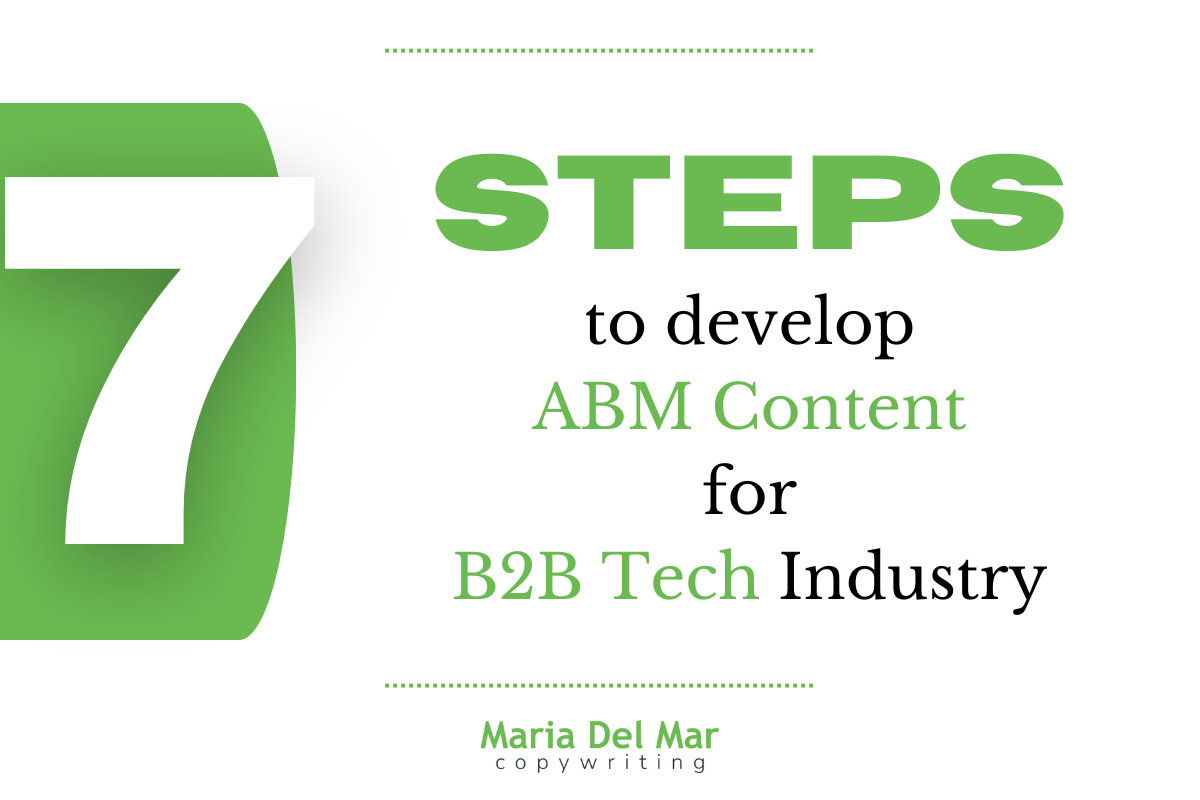What marketing strategies may B2B tech companies use to stand out in the current competitive market?
The answer is simple: ABM strategies.
This approach quickly became known as one of the most effective ways to support the growth of B2B tech enterprises.
Additionally, ABM strategies help tech businesses focus on a smaller number of high-value leads rather than trying to convert as many leads as possible, which makes it a more effective strategy to increase revenue and growth.
Without further ado, let’s delve into the definition of ABM, why it is a vital strategy for the tech industry, and the benefits it brings in this post. Also, I will outline the essential steps for developing successful ABM strategies.
What is an ABM?
Account- Based Marketing (ABM) is a strategic approach to identify high-value accounts and engage them with personalized marketing programs and initiatives tailored to their needs.
Another great definition of it is expressed by Jon Miller, CEO of Engagio and Co-Founder of Marketo, who says “ABM is a strategic approach that coordinates personalised marketing and sales efforts to open doors and deepen engagement at specific accounts.”
So, it’s fundamental that marketing and sales teams collaborate on identifying key accounts, understanding their needs and challenges, and building closer relationships through custom content and personal interaction.

What is an ABM strategy?
A successful ABM strategy begins with aligning sales and marketing teams.
Once they are aligned, they start the ABM strategy identifying and targeting best-fit accounts with the biggest revenue potential for your business.
The marketing team then leverages technology to deliver personalized messaging to decision-makers at these accounts on the channels they actively use.
This marketing effort is further strengthened by individualized, direct sales outreach to the same targeted accounts. By maintaining engagement with these key accounts throughout the entire customer journey—not just initially—businesses can generate positive momentum for revenue growth.
This comprehensive approach ensures that potential customers receive appropriate messages at every stage of their buying process, fostering strong relationships and addressing each decision-maker’s unique needs and challenges.
Why is ABM important in the tech industry?
You can’t grasp ABM’s importance in the tech industry without knowing some history.
Account-based marketing benchmarks have roots dating back to the 1990s, when B2C and B2B companies began to realize the need for more personalized marketing.
But the actual concept of account-based marketing was initially used by IT services firms – including Accenture, IBM and Xerox – that had major tech vendors for their largest accounts.
However, according to Terminus, it wasn’t until 2004 that the term was coined. by the ITSMA ABM certification, though many companies had already been implementing the strategies in one capacity or another for years.
Nevertheless, it wasn’t until recently, though, that ABM began to catch on due to the tech industry.
But why is ABM so hot right now in the tech industry?
Because marketers may use ABM to focus on smaller targets, or single accounts, and the important players and decision-makers inside those accounts, they can build campaigns that are more successful.
What resulted was a more personalized approach that produced higher-value leads. This, in turn, led to more opportunities, closing bigger deals, and maximizing growth.
Benefits of using an ABM strategy in tech industry
But it’s not only for the reasons mentioned in the previous paragraph, that it’s important to use ABM strategies in the tech industry right now.
For tech companies that are trying to sell into large accounts with long sales cycles and large deal sizes, account-based marketing offers many benefits over other marketing approaches:
- Achieves higher ROI
- Shorter and faster sales process
- Sales and Marketing teams are better aligned because both teams focus their efforts on the same accounts and have the same goals for them
- Improve cost-efficiency because every single effort is targeted, thus removing any excess effort or budget on accounts that are not the right fit for your business.
- Your brand stands out because treating each account individually allows brands to create personalized content that addresses specific needs, helping them stand out from competitors.
ABM content strategies

You can use many ABM content strategies to maximize your B2B account-based Marketing effectiveness. In fact, there are so many that it can become easy to get overwhelmed!
So, what I learned from my experience is that despite the many tactics or strategies, one thing remains the same: Content is king.
For ABM to work, you have to create high-value and engaging content tailored to the target account and its key buyers.
So to help you with this task, we’ll outline the essential steps when developing ABM content strategies in tech to ensure you achieve the best results.
Step 1: Set clear goals
The first step is setting out measurable targets for your AMB efforts, whether it’s boosting revenue, acquiring new customers, or expanding existing accounts.
Then, you can align your strategies and actions with these objectives, which will help you maintain focus and monitor progress efficiently.
Step 2: Pinpoint your high-value target accounts
To create the most impactful content, you have to focus on identifying the key stakeholders involved in the buying process.
Start by analyzing your existing customer base and market data to identify accounts that offer the greatest potential for growth and profitability.
Then, within these accounts, identify the decision-makers and influencers who will play crucial roles in the purchase decision.
Step 3: Understanding your audience is key
Understanding your audience deeply is essential for a successful ABM content strategy. It forms the bedrock of strategy development; without it, your entire plan could falter.
Crafting ideal customer personas allows you to effectively target your audience and anticipate their needs, facilitating the formulation of an ABM strategy.
To begin building these personas, gather data, conduct research, and collaborate with your team to identify common traits among your most successful customers.
Here are several tactics to consider as you develop your company’s Ideal Customer Profiles (ICPs):
- Leverage Sales Expertise: Tap into your sales team’s extensive customer interactions to pinpoint key ICP traits.
- Closed Won Analysis: Analyze successful accounts to uncover shared characteristics like company size, revenue, and industry.
- Market & Competitive Research: Look beyond your customer base to understand industry trends and competitive positioning.
Unlike generalized buyer personas, ICPs offer a precise, data-driven analysis of the customers you aim to attract.
Step 4: Determine KPIs
Before launching your ABM strategy, your team must establish key performance indicators (KPIs) to measure success.
Alongside selecting relevant KPIs, it’s essential to define specific goals. This process should involve input from both sales and marketing teams, ensuring alignment across the process.
Step 5: Evaluate existing content to identify any gaps
When you begin creating content for your personas, review the materials you already have.
Some existing content may be reusable, but you’ll need to audit it to find areas where it doesn’t align with your new account and personas.
You’ll need to modify and update your content to address the key stakeholders in the new account, and create new content if necessary to fill any gaps.
Repurposing old content is perfectly fine, but it must be tailored to specifically target the decision-makers in the new account. Otherwise, it won’t resonate and may go unnoticed.
Step 6: Produce personalized content tailored to stakeholders
One of the main challenges in ABM is crafting content that caters to each persona or stakeholder individually.
Although all stakeholders collaborate in the decision-making process, they each have unique perspectives and behaviors, influencing them differently. Thus, you need to create content that addresses them both individually and collectively.
Creating and planning personalized content for various stakeholders might seem overwhelming, but it’s vital for a successful ABM campaign. Personalized content enables each stakeholder to form a stronger connection with the solution you are offering.
You can also develop content that aligns with the goals of each persona. However, be cautious not to generalize too much, as this will lessen its effectiveness. It’s crucial to speak to the specific needs of each stakeholder identified as key to the decision-making process.
Step 7: Use analytics to track and measure performance
Lastly, it’s essential to implement an analytics strategy to track and measure the performance of your content.
Don’t wait until the end of the campaign to find out if your content was ineffective. Instead, monitor and evaluate your efforts throughout the process.
This allows you to make adjustments as needed and gather insights to optimize your content moving forward.
Personalization is the heart of account-based marketing
Launching ABM content strategies with highly personalized content is challenging. It demands extensive research to fully comprehend the account and identify the key decision-makers.
This involves not only understanding their roles and responsibilities but also their individual preferences and pain points. By addressing these elements, your content can resonate more deeply and drive better engagement.
As an expert SEO copywriter and B2B content marketer, I can help you develop ABM content strategies to meet these challenges head-on and achieve your marketing goals.
